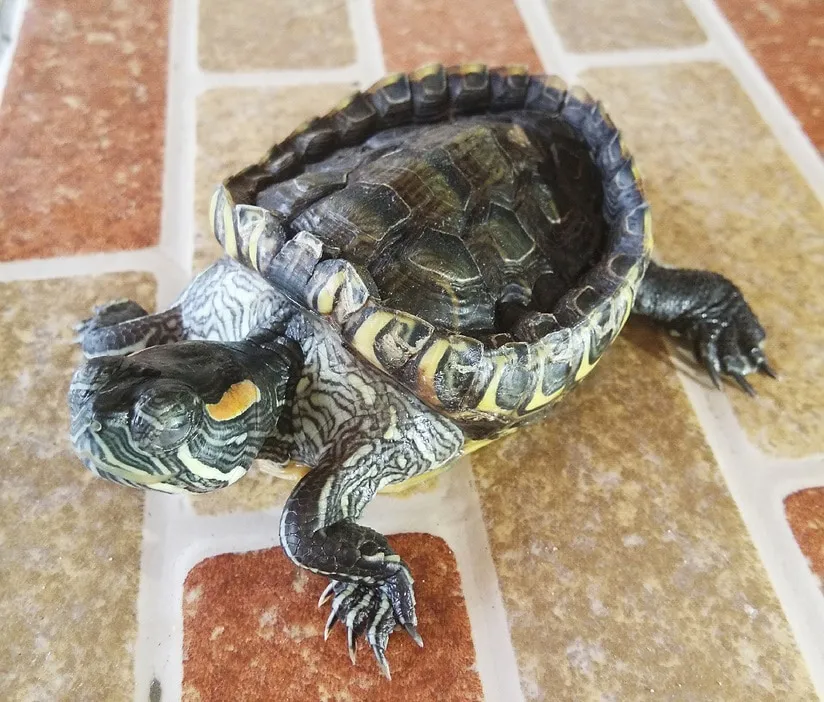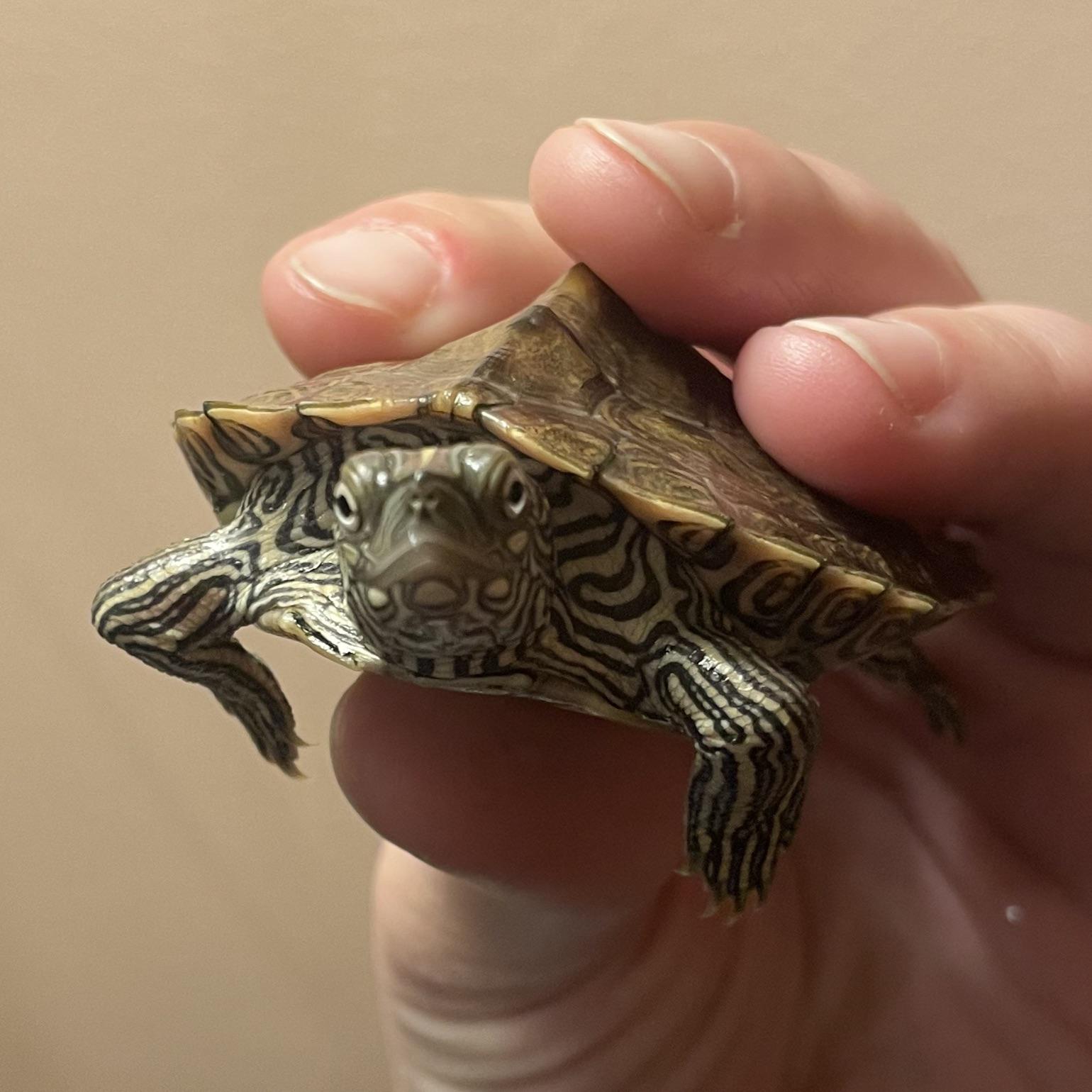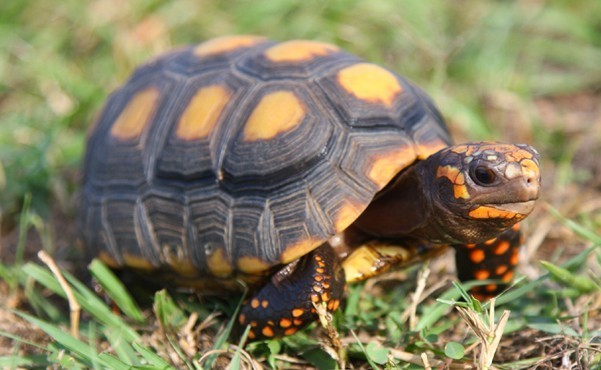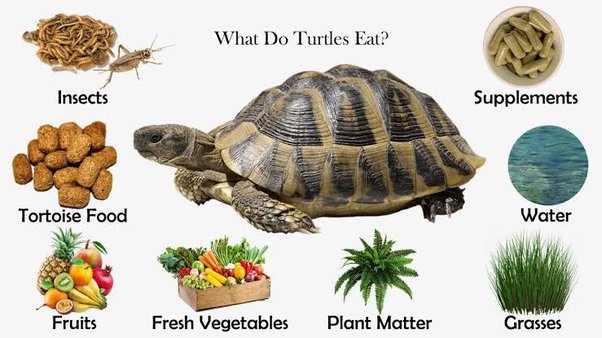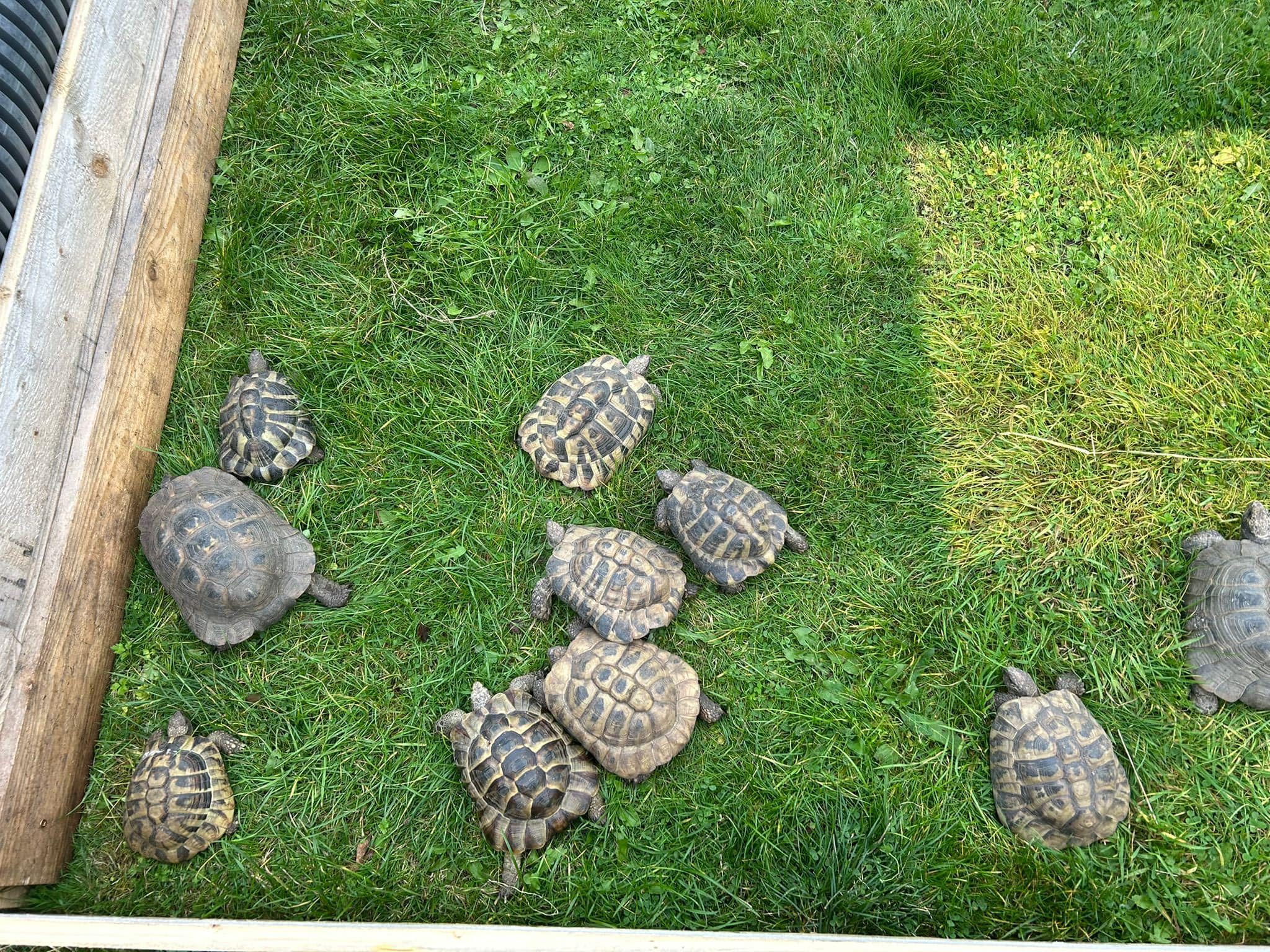
Diamondback Terrapin
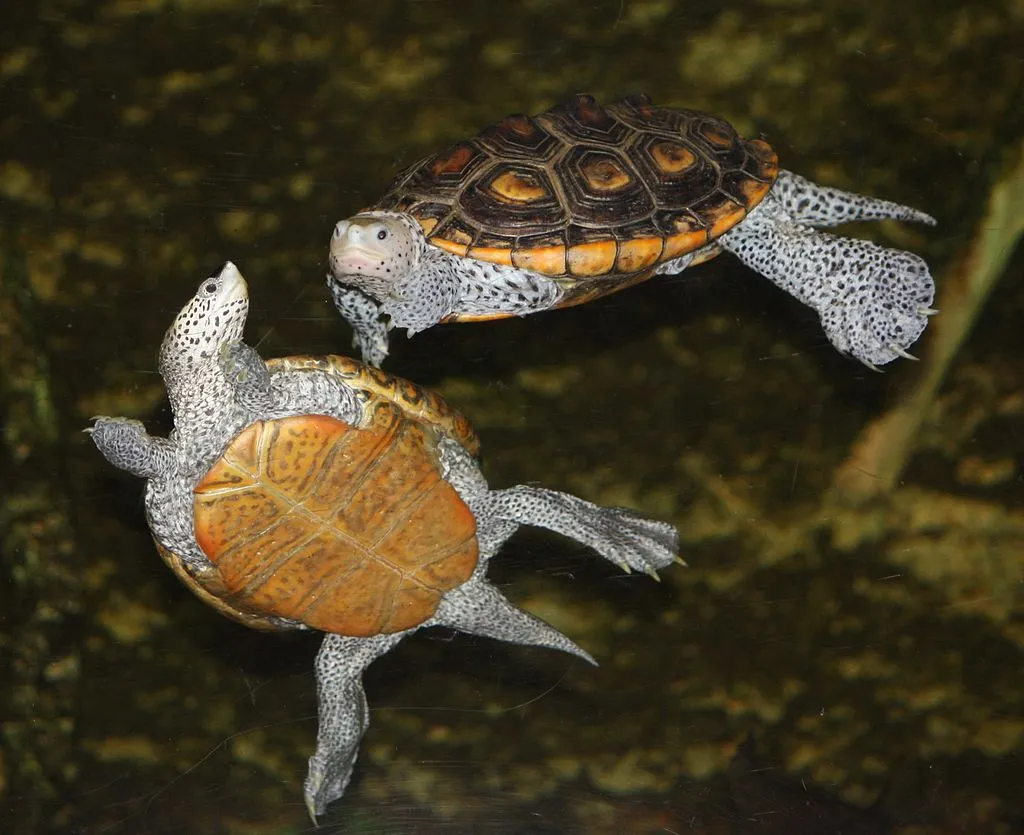
Diamondback Terrapins are the true Terrapin species. Diamondback Terrapins are aquatic animals with concentric, diamond-shaped markings and grooves on the scutes (plates) of their carapaces (top shells). This can range from medium grey or brown to nearly black. Their skin can be pale grey to black, marked with dark spots, blotches or stripes. No two Diamondback Terrapins are exactly alike in colour and pattern. They also have large webbed feet and muscular legs. A Diamondback Terrapins lifespan is typically between 25 and 40 years.
Mud Turtle
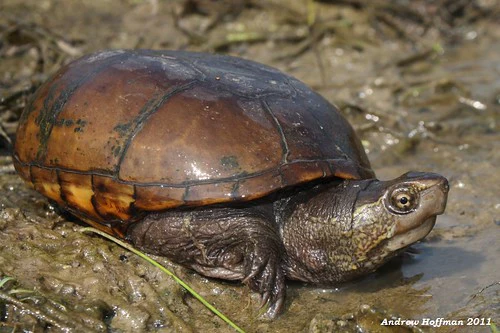
Mud Turtles also known as Kinosternon are small, aquatic reptiles. They are typically 3-5 inches long. The upper shell (carapace) is smooth, keelless, and olive to dark brown in colour. The lower shell (plastron) is yellow to brown and double hinged. Male Mud Turtles have a blunt spine at the tip of their tail, they also have rough scaly patches on the inside of their hind legs. The head of an adult Mud Turtle is generally uniform in colour. They have a side-necked retraction, meaning they retract their head sideways instead of vertically into their shell. In the wild, they can live between 20-40 years, in captivity, they can live up to 50.
Painted Turtle
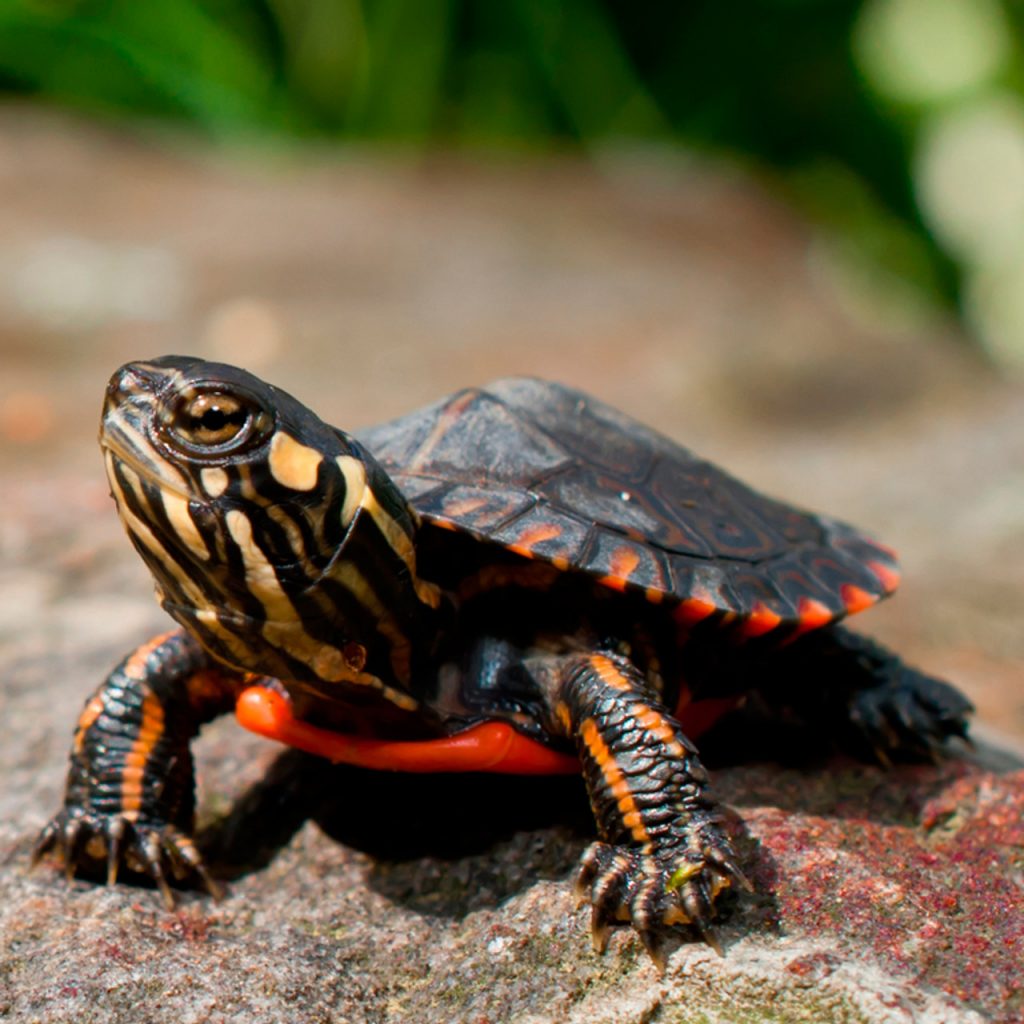
The Painted Turtle scientifically known as Chrysemys picta is a medium sized aquatic Turtle with a dark coloured upper carapace (upper shell) and bright red markings on the plastron (lower shell) and a marginal carapace (edge of shell). The skin is black to olive with yellow striped on the head, neck, legs, and tail. Fully grown adults range in size from 2.5 to 10 inches. They can live up to 40 years, however the oldest documented Painted Turtle reached 55 years old.
Red-eared Terrapin
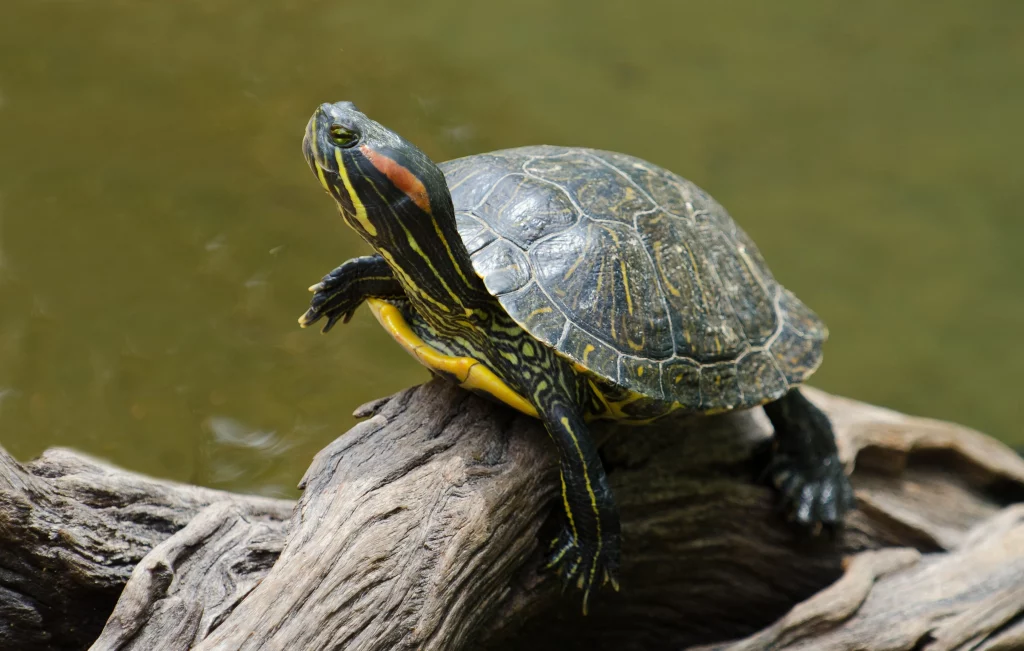
Red-eared Terrapin also known as Trachemy scripta elegans. The Red-eared Slider or Red-eared Terrapin is a subspecies of the pond slider, a semi-aquatic turtle belonging to the family Emydidae. These are medium to large sized freshwater Terrapins with distinctive red stripes behind their eyes. Olive to brown carapaces with yellow stripes and spots, and yellow plastrons with dark spots in the centre of each shell plate. They can grow up to 12 inches long, but are more commonly 15-20 cm.
River Cooter
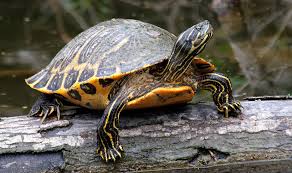
River Cooter also known as Pseudemys concinna is a species of freshwater Turtle in the family Emydidae. They are medium to large aquatic Turtles with dark greenish-brown upper shell, with a yellow to reddish-orange lower shell. They have yellow stripes on their head, neck, and chin, and a “C” marking in the second scale of their shell.
Peninsula Cooter
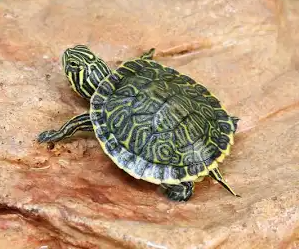
Peninsula Cooter scientifically known as Pseudemys peninsularis. Females grow to 10-14 inches, while males grow to 10-12 inches long. Peninsula cooters have a moderately domed carapace with dark coloring and light yellow or orange parallel lines. Their plastron is unhinged and has a nondescript pattern. They also have dark skin with yellow stripes around the head and neck. Hatchlings are more green in color, but their appearance changes as they mature.
Florida red-bellied Cooter
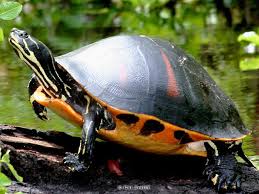
Florida red-bellied Cooter also known as Pseudemys nelsoni and Florida redbelly Turtle. They have black, domed carapace with yellow or orange markings. The plastron is red or orange. Adult Florida red-bellied Cooters can range from 8–14.8 inches in length, with females being larger than males. They have bright yellow stripes on their heads and necks. They have two cusps (like teeth) on their upper beak. Males have longer front claws than females. Males have thicker tails than females.
Northern red-bellied Cooter
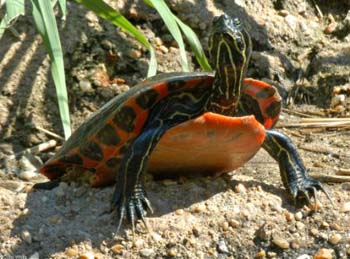
Northern red-bellied Cooter also known as Pseudemys nelsoni. Females are usually larger than males, averaging 12 inches. Adults have black to brown upper shells with faint reddish markings, and a reddish or orange lower shell with a dark pattern in young turtles. The head, neck, limbs, and tail are black with yellow or ivory lines. Adults have black to brown upper shells with faint reddish markings, and a reddish or orange lower shell with a dark pattern in young turtles. A notched upper jaw with a tooth-like cusp on either side, and a yellow arrow-shaped stripe along the throat and neck.
Coastal Plain Cooter
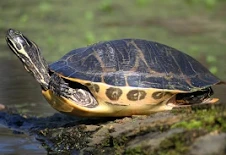
The Coastal Plain Cooter (Pseudemys floridana) or Florida Cooter is a large aquatic Turtle reaching a maximum length of 15.6 inches. Females are usually larger than males. The carapace is light to dark brown with concentric markings, and the plastro is yellow. The shell is highly elevated with the highest point in the middle. The arms and legs are dark brown with yellow stripes. The head had a short yellowish line that extends to the tip of the snout, and the chin and neck stripes are wider than the dorsal head stripes.
Snake necked Turtle
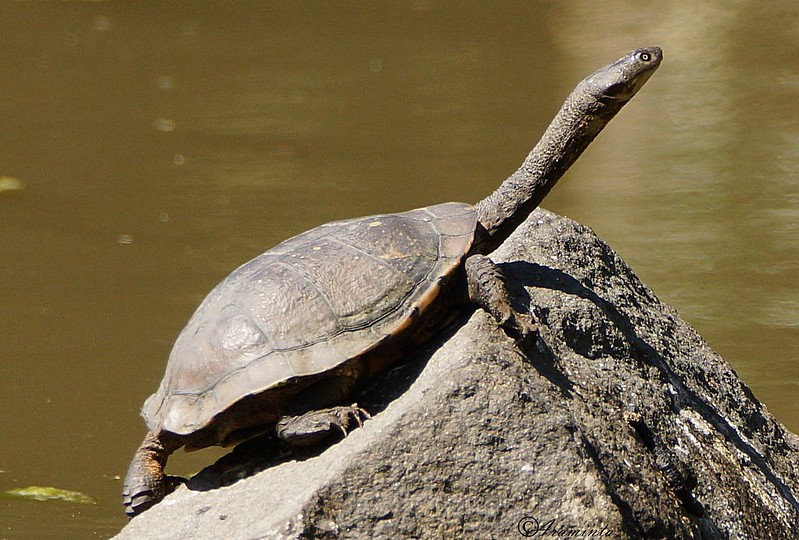
Snake necked Turtle scientifically known as Chelodina which are known for their long necks, which can be more than half the length of their shell. They are a type of Side-necked Turtle, meaning they tuck their heads sideways into their shells instead of pulling them back directly. The shell is pale grey and oval in shape, growing wider towards the tail end. The neck is darker, with a light underside and the face has ringed eyes. Females are usually physically bigger than the males.
Wood Turtle
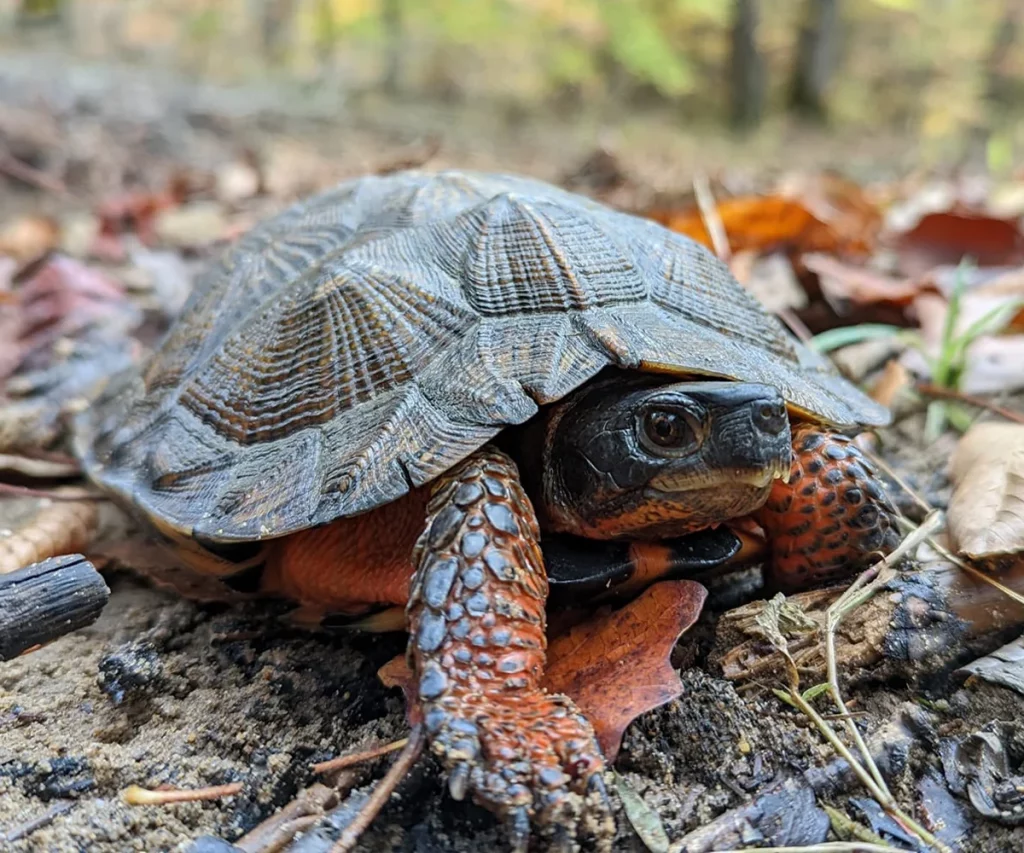
Wood Turtles also known as Glyptemys insculpta, they are a species of turtle in the family Emydidae, which live on land but love to go into water. They are small to medium sized freshwater Turtles. Wood Turtles have a broad, low, and sculpted upper shell (carapace) that is tan, greyish brown, or brown with yellow and black lines. The bottom shell (plastron) is yellow with black blotches on the outer corner of each scute. The head is black, and the neck, underside of the legs, and tail are yellow, orange, or red.
Yellow-bellied Terrapin
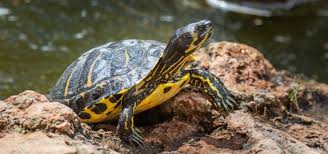
Yellow-bellied Terrapin scientifically known as Trachemys scripta are distinguished by their shells, which are brown or black with yellow stripes. Medium to large Terrapins. Their plastron is yellow with black spots, hence its name. They have an “S” shaped lining on the side of the heads more of a curve, which is why it’s hard to tell the difference between the Yellow-bellied and the Cooter.
African side necked Turtle
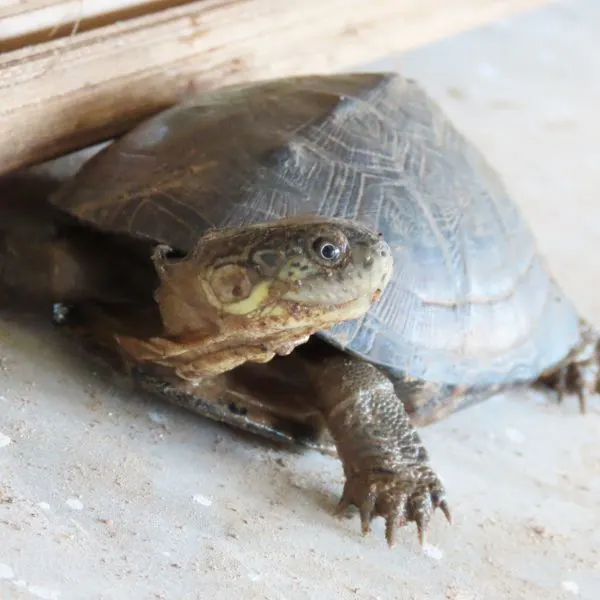
African side necked Turtle scientifically known as Pelomedusidae, ranges in size from 12 to 45 cm. Their shell is often dark brown, and their skin ranges from olive to brown with black markings on the top of their head. They have large, round eyes and a mouth that looks like it’s fixed into a permanent smile.They have dark brown shells, olive to brown skin, and black markings on their heads. Their underbellies, or plastrons, are grayish black with a yellow area. They also have two barbels, or beard-like sensory organs, on their lower jaw.
Pink Bellied Side-necked Turtle
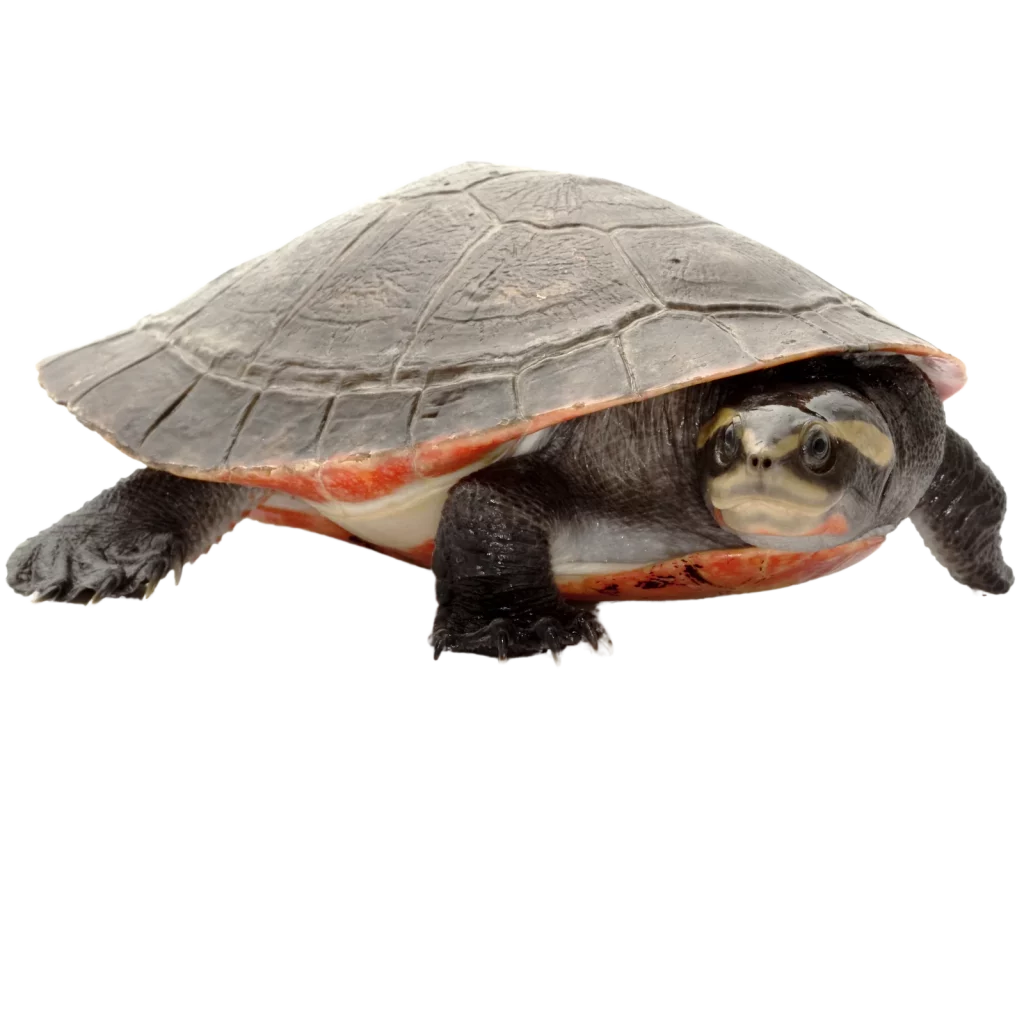
Pink Bellied Side-necked Turtle also known as Emydura subglobosa. They have an olive coloured head, a yellow stripe that runs from the tip of its nose through its eyes, and two yellow whiskers on its chin. The carapace can range in colour from beige to chestnut brown or slate grey, while the plastron is pink. As the turtle grows, its skin develops additional red or orange markings. They can grow up to 10 inches long.
Reeves Turtle
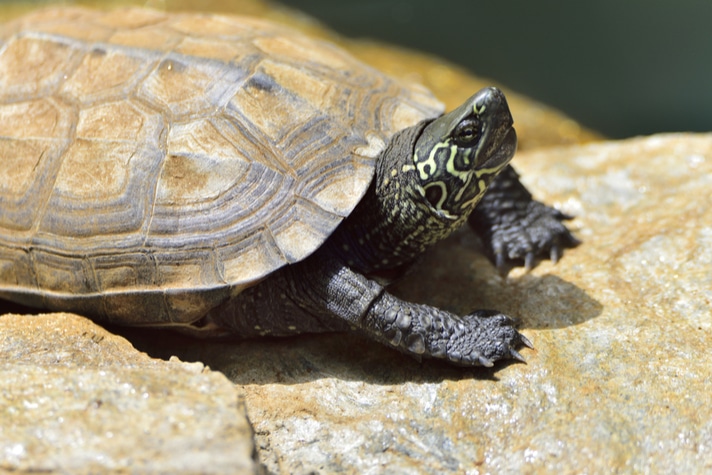
Reeves Turtle is also known as a Chinese Pond Turtle but is scientifically known as Mauremys reevesii. Adults grow to 5 inches. Males are usually smaller than females. They have a brown or tan carapace with three strong keels, webbed legs, and a long tail. Their head and neck are black and yellow, and their bodies are usually gray with yellowish spots. However, some Reeve’s turtles can be completely black or dark brown.
Chinese softshell Turtle
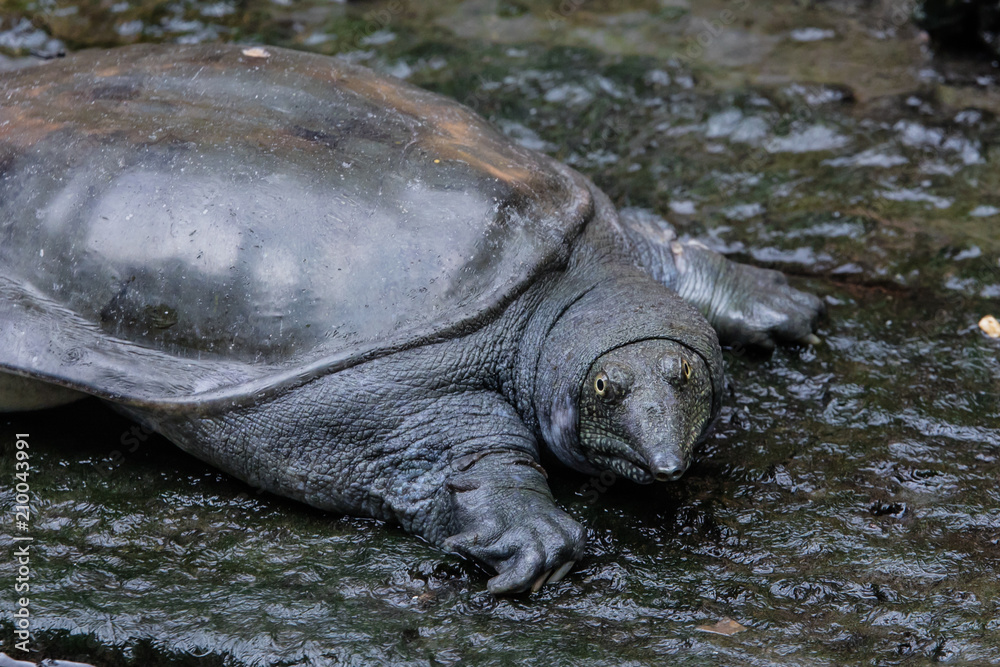
Chinese Softshell Turtle also known as Pelodiscus sinensis. They are small to medium sized, with a carapace length of 4.5 to 10 inch. The carapace is leathery and pliable, particularly at the sides – oval, with a slight sucken ridge in males. The central part of the carapace has a layer of solid bone beneath it, as in other Turtles, but this is absent at the outer edges. The light and flexible shell of this Turtle allows it to move more easily in open water, or in muddy lake bottoms. When young they have olive grey to greenish brown with yellow-bordered black spots and yellowish dots, but adults tend to be uniformly olive. Mottled throat, and small, dark bars on the lips.
Chinese stripe-necked Turtle
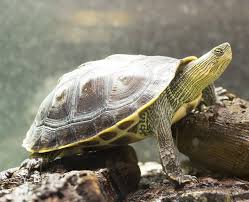
Chinese stripe-necked Turtle also known as Golden thread Turtle, but is scientifically known as Mauremys sinensis. These are a medium sized feshwater Turtle, that can grow upto 30cm long, with the females being larger than males. The most distinctive feature is the yellow stripes that run from its nose, over its face, and down its neck. The shell of an adult Chinese stripe-necked Turtle is usually a dark brown or grey colour, but can also have a greenish hue. Young Turtles have a shell with extended red spots.The Turtle has a narrow head, with a cream-coloured jaw and chin. The plastron is ivory with black spots.
Common box Turtle
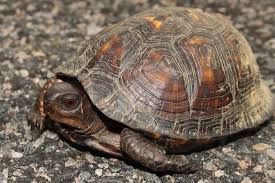
The Common Box Turtle also known as Terrapene carolina has a high-domed, hinged shell that allows it to close up like a box. The shell is usually dark brown or black with yellow or orange markings. The plastron, is dark brown and hinged. They typically grow to 5-6 inches, having a hooked upper jaw and a significant overbite. Male box turtles have bright red or orange eyes, while females have dark red or brown eyes. Male box Turtles have a shorter, thicker tail than females. The male box Turtles have short, thick, curved hind claws, while females’ hind claws are long, straight and thin.
Common Musk Turtle
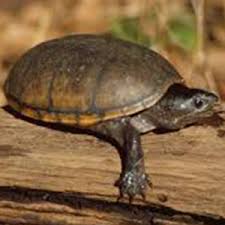
Common Musk Turtle also known as Sternotherus odoratus, Eastern Musk Turtle, or stinkpot Turtle due to its ability to release a foul musky odor from scent glads when feeling threatened. A fully grown musk grows to 3-5 inches. Males can be determined by the longer tail and overall larger size. Their shell is smooth, domed carapace can be black,grey or olive brown, and may have dark spots or streaks. Thye plastron is yellow to brown. They have a pair of yellow or green facial stripes running from the tip of their nose to the neck, one on either side of the eye.
Razorback Musk Turtle
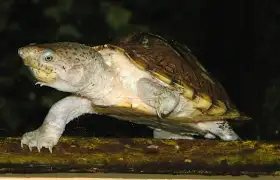
Razorback Musk Turtle scientifically known as Sternotherus carinatus can grow to be about 12-15 cm long. When young they are cream or tan with brown speckles, but as they grow their shells darken to brown with darker rings, and their bodies turn grey with spotting. The Razorback Musk Turtle’s shell has a sharp keel running down the center, which gives it its name. They have a large, bulbous head with a sharp beak, and they have a long neck and short legs. Males have longer tails than females. The plastron has one hinge at the front. The Razorback Musk Turtle also has barbels on its chin.
Flattened Musk Turtle
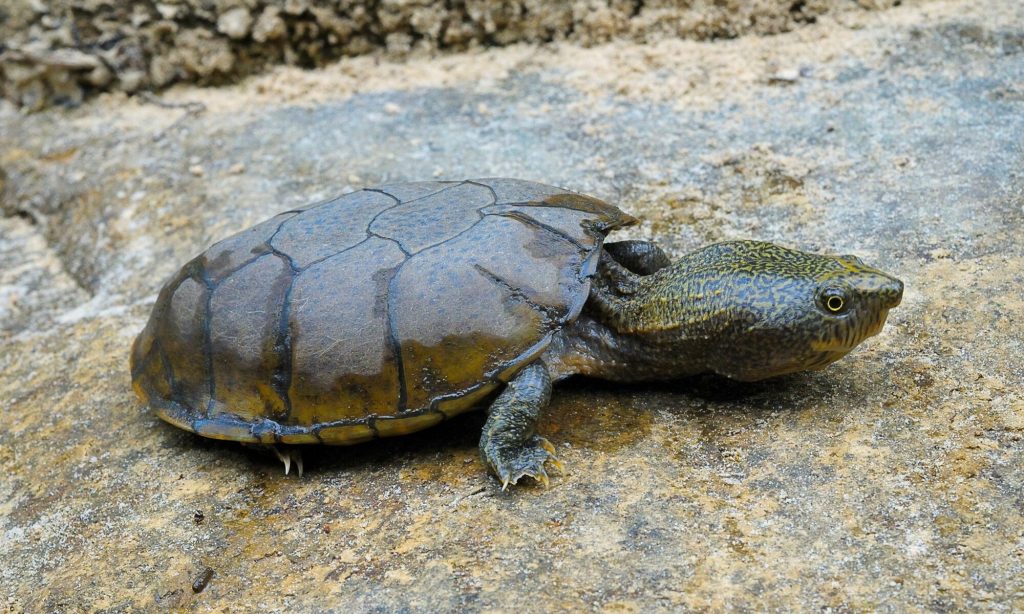
Flattened Musk Turtle scientifically known as Sternotherus depressus is a small, aquatic Turtle with a distinctive flattened carapace. The carapace is dark brown to orange with dark seams, this flattens as the Turtle ages. The plastron is pink or yellow-brown. The Turtles head and neck are greenish with dark lines. Male Flattened Musk Turtles have thick, long tails with spines on the tips. They have barbels on their chins. Adults can reach up to 4.7 inches.
Intermediate Musk Turtle
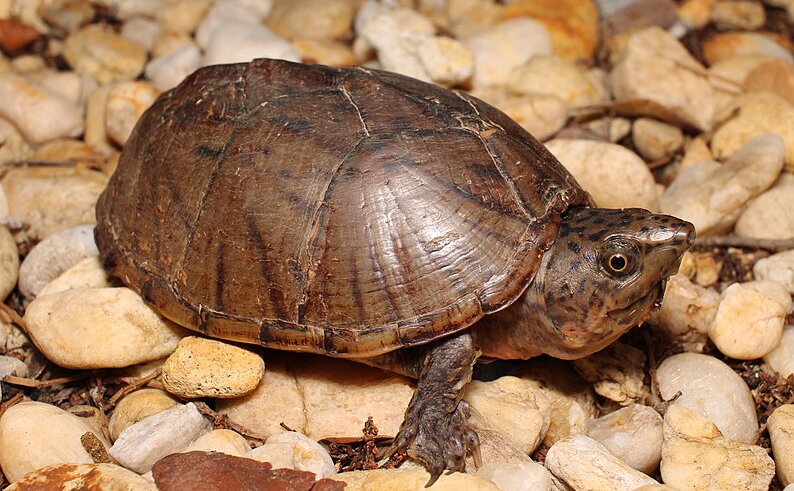
Intermediate Musk Turtle scientifically known as Sternotherus intermedius. They are a small Turtle with a shell length of about 3-5 inches. The carapace is oval, dull in colour, and has intermediate patterns. Their head is large with a pointed snout, with a long neck with barbels on the chin and underside.
Loggerhead Musk Turtle
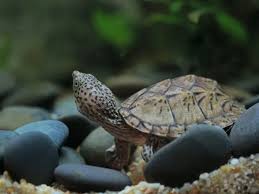
Loggerhead musk turtle also known as Sternotherus minor. Males can have a carapace length of up to 12 cm, while females can reach 14.5 cm. They have large heads with pointed snouts and powerful, hooked jaws. Their heads are light-colored with dark spots or stripes, and they have a pair of barbels under their lower jaw. The carapace has a noticeable vertebral keel, and juveniles may also have two dorsolateral keels. The carapace colour ranges from dark brown to orange, but they always have a darker border. The plastron is small and a clear pinky-yellow colour. Males have long, spine-tipped tails with a swelling at the base. Females have shorter, slimmer tails with the anus positioned closer to the plastron. The limbs of a Loggerhead Musk Turtle are speckled with dark spots, and the skin around them is papillose.
Mississippi Map Turtle
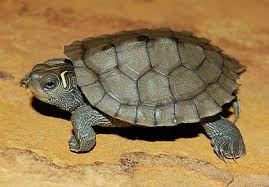
The Mississippi Map Turtle, also known commonly as Kohn’s Map Turtle. The carapace is brown or olive with a prominent ridge running down the centre. The back edge of the carapace is serrated (ridged bumps), and the plastron, is light green-yellow with wood-like lines. The Mississippi map turtle has bright eyes with round pupils and solid, unbroken irises. It also has bright yellow reverse-crescents that run under and behind its eyes. Females are larger than males, with mature females being twice the length and 10 times the mass of mature males.
Northern Map Turtle
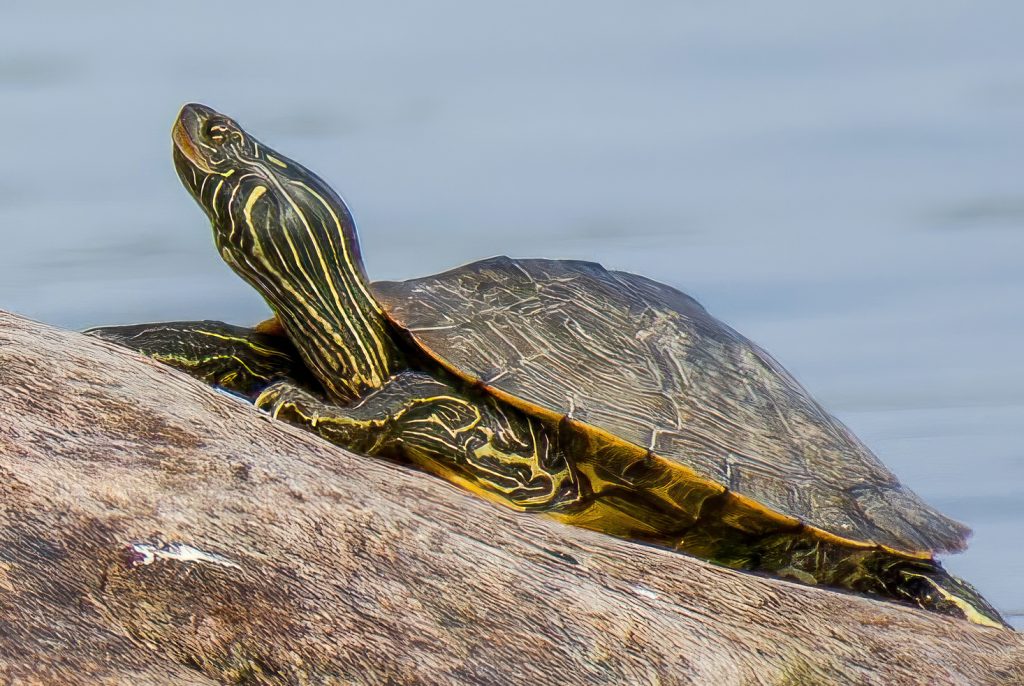
Northern Map Turtle with the scientific name as Graptemys geographica, but commonly known as the Common Map Turtle, is named for the markings on its shell, which look like the contour lines on a topographical map. The carapace is olive green with fine yellow lines and has a distinct ridge (keel) along the centre and serrations along its back edge. Both the head and legs have a pattern with bright yellow lines. This Turtle has a yellow spot behind the eyes. The plastron (lower shell) is cream to yellow in adults, but in juveniles the plastron has dark lines along the seams. Females get much larger than males and grow up to 27 centimetres in carapace length, whereas males grow to only 14 centimetres long.
Black-knobbed Map Turtle
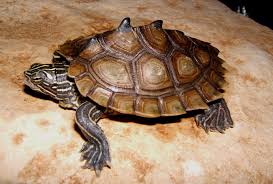
Black-knobbed Map Turtle, formerly known as the Black-Knobbed Sawback, is a small to medium-sized aquatic turtle with light gray skin. Some of the most distinguishing characteristics of the Black-Knobbed Map Turtle are the protruding “spikes” on the Turtle’s carapace. The carapace is dark olive-brown in colour, with each plate, of the shell being yellow-green circular rings which are outlined in black. The head is small, and is dark brown with yellow stripes, with yellow crescents behind the eye facing towards the posterior end of the turtle. These stripes continue on the legs of the turtle also, with the underside of the leg being lighter than the dorsal surface. Females are roughly twice the size of males, ranging from 3-7.5 inches, while males are 3-4inch.
Ouachita Map Turtle
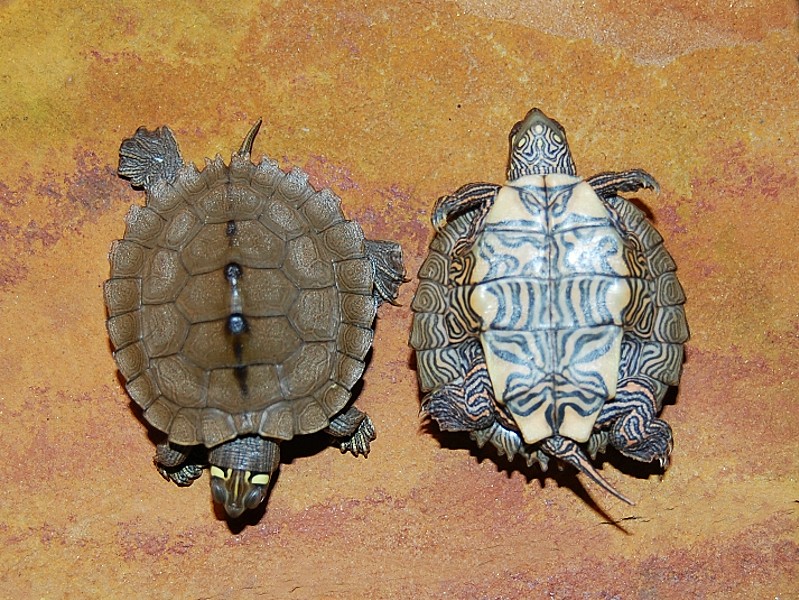
Ouachita Map Turtle known as Graptemys ouachitensis. The carapace is olive, dark brown, or black with a raised ridge in the middle and a serrated rear. It also has narrow, irregular yellow lines that resemble a map. The plastron is flat and yellow with dark lines and swirls, and a faint grey streak along the seams.The head is dark brown or olive drab with light yellow spots behind and below each eye, and on each side of the lower jaw. The eyes are cream to white with a thin black horizontal line across the pupil. Females are larger than males growing to 10 inch, while males grow to 5 inch. Young Ouachita map turtles have a row of saw-toothed knobs down the center of their back that wear down with age. Males usually keep pronounced knobs, but they may be hard to detect in large females. Females have broader jaws than males, allowing them to eat larger and harder foods.
Pearl RIver Map Turtle
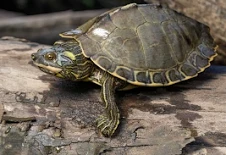
Pearl River Map Turtle also known as Graptemys pearlensis is a medium to large freshwater Turtle with a map-like pattern on its shell and a broad light-coloured blotch between its eyes. The shell is brown or olive with light yellow rings on the front , and has a pronounced keel and row of dorsal spines. Their head has a large blotch that connects to a pair of posterbital blotches, often forming a trident on top of the nose. Females grow to 9-10.5inches, while males grow to 3.5-4.5 inches long.
Cagle’s Map Turtle
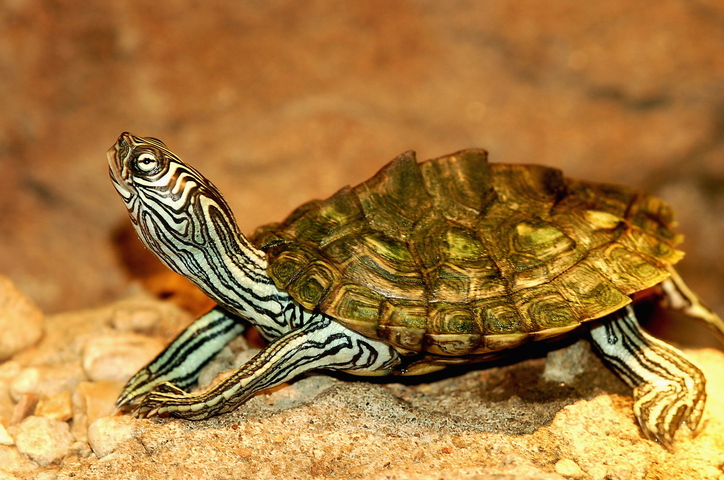
Cagle’s Map Turtle also known as Graptemys caglei. Males grow to reach 4.9inches, while females grow to 8.3 inches. Males also have a longer tail than females. The carapace is elliptical in dorsal view and flattened in lateral view, with a slight mid-line keel. The carapace is dark yellow to brown with brown to black swirl-like markings on each scute. The plastron is cream in color with dark patterning along the seams. The skin is dark green with white or cream markings. The neck, limbs, and tail are creamy yellow with dark colored stripes. Cagle’s Map Turtles have a prominent V-shaped marking on the top of their head leading to their eye area. They have a cream colored transverse bar on the chin just behind the cusp.
False Map Turtle
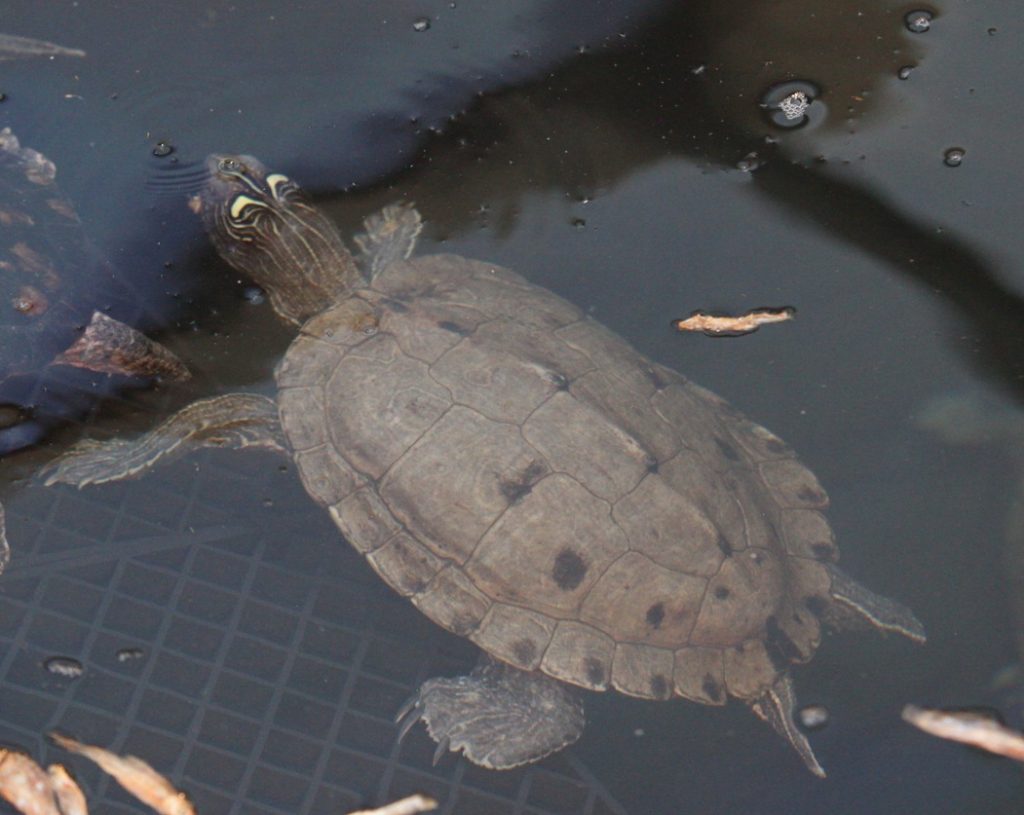
False Map Turtle (Graptemys pseudogeographica) is a medium to large turtle with a distinctive carapace. The carapace is olive to brown with yellow markings, a low keel, and a serrated posterior edge. Young Turtles have a row of saw-toothed knobs down the center of their back that wear down with age. The plastron is cream to yellow with a seam pattern that also fades with age. The body colour of the False Map Turtle is grayish brown to blackish and is marked with light brown, yellow, or whitish stripes. The eye can be brown, light yellow, white, or green and is crossed with a dark bar. Narrow hooked marks (hockey-stick- or L-shaped) behind the eye fuse with dorsal lines on the head and neck.
Common Snapping Turtle
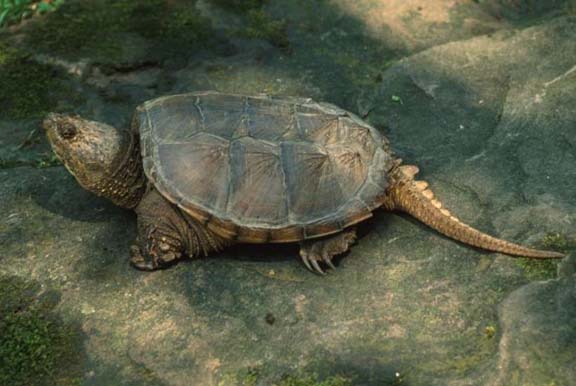
Common Snapping Turtle also known as Chelydra serpentina is a large species of freshwater turtle in the family Chelydridae. Said to be native since the seventeenth century. The common snapping turtle is noted for its combative disposition when out of water with its powerful beak-like jaw, and highly mobile head and neck. Snapping turtles generally reach maturity at 8-10 years and can live up to 40 years or more. They have a muscular build, a large head, a long neck, and a long tail. They have a ridged upper shell, or carapace, that can be tan, brown, or black in color. Their lower shell is small and cross-shaped.
Alligator Snapping Turtle
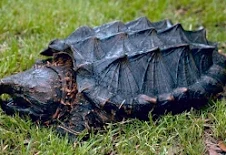
Alligator Snapping Turtle scientifically known as Macrochelys temminckii. The shell is dark brown and has large prominent spikes and raised plates called keels. The spikes gradually flatten out as the Turtle ages. They have a large, heavy head with a hooked beak and eyes on the side of its head. Male adults can reach 29 inches, while adult females can reach 22 inches. The Alligator Snapping Turtle has a long, thick tail covered in scales. It also has muscular legs with webbed toes and long, pointed claws. They have radiating yellow patterns around its eyes, and fleshy, filamentous “eyelashes” that surround its eyes in a star-shaped arrangement.
